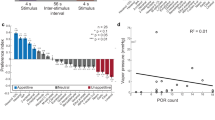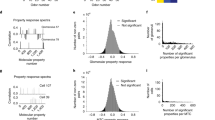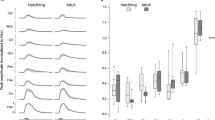Abstract
Here we describe several fundamental principles of olfactory processing in the Drosophila melanogaster antennal lobe (the analog of the vertebrate olfactory bulb), through the systematic analysis of input and output spike trains of seven identified glomeruli. Repeated presentations of the same odor elicit more reproducible responses in second-order projection neurons (PNs) than in their presynaptic olfactory receptor neurons (ORNs). PN responses rise and accommodate rapidly, emphasizing odor onset. Furthermore, weak ORN inputs are amplified in the PN layer but strong inputs are not. This nonlinear transformation broadens PN tuning and produces more uniform distances between odor representations in PN coding space. In addition, portions of the odor response profile of a PN are not systematically related to their direct ORN inputs, which probably indicates the presence of lateral connections between glomeruli. Finally, we show that a linear discriminator classifies odors more accurately using PN spike trains than using an equivalent number of ORN spike trains.
This is a preview of subscription content, access via your institution
Access options
Subscribe to this journal
Receive 12 print issues and online access
$209.00 per year
only $17.42 per issue
Buy this article
- Purchase on Springer Link
- Instant access to full article PDF
Prices may be subject to local taxes which are calculated during checkout









Similar content being viewed by others
References
Bargmann, C.I. Comparative chemosensation from receptors to ecology. Nature 444, 295–301 (2006).
Mombaerts, P. Genes and ligands for odorant, vomeronasal and taste receptors. Nat. Rev. Neurosci. 5, 263–278 (2004).
Laissue, P.P. et al. Three-dimensional reconstruction of the antennal lobe in Drosophila melanogaster. J. Comp. Neurol. 405, 543–552 (1999).
Hallem, E.A. & Carlson, J.R. The odor coding system of Drosophila. Trends Genet. 20, 453–459 (2004).
Couto, A., Alenius, M. & Dickson, B.J. Molecular, anatomical, and functional organization of the Drosophila olfactory system. Curr. Biol. 15, 1535–1547 (2005).
Fishilevich, E. & Vosshall, L.B. Genetic and functional subdivision of the Drosophila antennal lobe. Curr. Biol. 15, 1548–1553 (2005).
Stopfer, M. & Laurent, G. Short-term memory in olfactory network dynamics. Nature 402, 664–668 (1999).
Bazhenov, M., Stopfer, M., Sejnowski, T.J. & Laurent, G. Fast odor learning improves reliability of odor responses in the locust antennal lobe. Neuron 46, 483–492 (2005).
Derby, C.D. & Ache, B.W. Quality coding of a complex odorant in an invertebrate. J. Neurophysiol. 51, 906–924 (1984).
Mathews, D.F. Response patterns of single neurons in the tortoise olfactory epithelium and olfactory bulb. J. Gen. Physiol. 60, 166–180 (1972).
Duchamp, A. Electrophysiological responses of olfactory bulb interneurons to odor stimuli in the frog. A comparison with receptor cells. Chem. Senses 7, 191–210 (1982).
Ng, M. et al. Transmission of olfactory information between three populations of neurons in the antennal lobe of the fly. Neuron 36, 463–474 (2002).
Wang, J.W., Wong, A.M., Flores, J., Vosshall, L.B. & Axel, R. Two-photon calcium imaging reveals an odor-evoked map of activity in the fly brain. Cell 112, 271–282 (2003).
Wilson, R.I., Turner, G.C. & Laurent, G. Transformation of olfactory representations in the Drosophila antennal lobe. Science 303, 366–370 (2004).
Pologruto, T.A., Yasuda, R. & Svoboda, K. Monitoring neural activity and [Ca2+] with genetically encoded Ca2+ indicators. J. Neurosci. 24, 9572–9579 (2004).
Sankaranarayanan, S. & Ryan, T.A. Real-time measurements of vesicle-SNARE recycling in synapses of the central nervous system. Nat. Cell Biol. 2, 197–204 (2000).
Shadlen, M.N. & Newsome, W.T. The variable discharge of cortical neurons: implications for connectivity, computation, and information coding. J. Neurosci. 18, 3870–3896 (1998).
Kara, P., Reinagel, P. & Reid, R.C. Low response variability in simultaneously recorded retinal, thalamic, and cortical neurons. Neuron 27, 635–646 (2000).
Vogel, A., Hennig, R.M. & Ronacher, B. Increase of neuronal response variability at higher processing levels as revealed by simultaneous recordings. J. Neurophysiol. 93, 3548–3559 (2005).
Stocker, R.F., Heimbeck, G., Gendre, N. & de Belle, J.S. Neuroblast ablation in Drosophila P[GAL4] lines reveals origins of olfactory interneurons. J. Neurobiol. 32, 443–456 (1997).
de Bruyne, M., Clyne, P.J. & Carlson, J.R. Odor coding in a model olfactory organ: the Drosophila maxillary palp. J. Neurosci. 19, 4520–4532 (1999).
de Bruyne, M., Foster, K. & Carlson, J.R. Odor coding in the Drosophila antenna. Neuron 30, 537–552 (2001).
Budick, S.A. & Dickinson, M.H. Free-flight responses of Drosophila melanogaster to attractive odors. J. Exp. Biol. 209, 3001–3017 (2006).
Hallem, E.A. & Carlson, J.R. Coding of odors by a receptor repertoire. Cell 125, 143–160 (2006).
Hallem, E.A., Ho, M.G. & Carlson, J.R. The molecular basis of odor coding in the Drosophila antenna. Cell 117, 965–979 (2004).
Olsen, S.R., Bhandawat, V. & Wilson, R.I. Excitatory interactions between olfactory processing channels in the Drosophila antennal lobe. Neuron 54, 89–103 (2007).
Shang, Y., Claridge-Chang, A., Sjulson, L., Pypaert, M. & Miesenbock, G. Excitatory local circuits and their implications for olfactory processing in the fly antennal lobe. Cell 128, 601–612 (2007).
Laughlin, S. A simple coding procedure enhances a neuron's information capacity. Z. Naturforsch. [C] 36, 910–912 (1981).
Perez-Orive, J. et al. Oscillations and sparsening of odor representations in the mushroom body. Science 297, 359–365 (2002).
Marin, E.C., Jefferis, G.S., Komiyama, T., Zhu, H. & Luo, L. Representation of the glomerular olfactory map in the Drosophila brain. Cell 109, 243–255 (2002).
Wong, A.M., Wang, J.W. & Axel, R. Spatial representation of the glomerular map in the Drosophila protocerebrum. Cell 109, 229–241 (2002).
Tanaka, N.K., Awasaki, T., Shimada, T. & Ito, K. Integration of chemosensory pathways in the Drosophila second-order olfactory centers. Curr. Biol. 14, 449–457 (2004).
Simoncelli, E.P. Vision and the statistics of the visual environment. Curr. Opin. Neurobiol. 13, 144–149 (2003).
Shadlen, M.N. & Newsome, W.T. Noise, neural codes and cortical organization. Curr. Opin. Neurobiol. 4, 569–579 (1994).
Berry, M.J., Warland, D.K. & Meister, M. The structure and precision of retinal spike trains. Proc. Natl. Acad. Sci. USA 94, 5411–5416 (1997).
Alonso, J.M., Usrey, W.M. & Reid, R.C. Rules of connectivity between geniculate cells and simple cells in cat primary visual cortex. J. Neurosci. 21, 4002–4015 (2001).
Berry, M.J. II & Meister, M. Refractoriness and neural precision. J. Neurosci. 18, 2200–2211 (1998).
Shanbhag, S.R., Muller, B. & Steinbrecht, R.A. Atlas of olfactory organs of Drosophila melanogaster. 1. Types, external organization, innervation, and distribution of olfactory sensilla. Int. J. Insect Morphol. Embryol. 28, 377–397 (1999).
Armstrong-Gold, C.E. & Rieke, F. Bandpass filtering at the rod to second-order cell synapse in salamander (Ambystoma tigrinum) retina. J. Neurosci. 23, 3796–3806 (2003).
Stopfer, M., Jayaraman, V. & Laurent, G. Intensity versus identity coding in an olfactory system. Neuron 39, 991–1004 (2003).
Mazor, O. & Laurent, G. Transient dynamics vs. fixed points in odor representations by locust antennal lobe projection neurons. Neuron 48, 661–673 (2005).
Laughlin, S.B., Howard, J. & Blakeslee, B. Synaptic limitations to contrast coding in the retina of the blowfly Calliphora. Proc. R. Soc. Lond. B 231, 437–467 (1987).
Laurent, G. Olfactory network dynamics and the coding of multidimensional signals. Nat. Rev. Neurosci. 3, 884–895 (2002).
Schlief, M.L. & Wilson, R.I. Olfactory processing and behavior downstream from highly selective receptor neurons. Nat. Neurosci. 10, 623–630 (2007).
Nozawa, M. & Nei, M. Evolutionary dynamics of olfactory receptor genes in Drosophila species. Proc. Natl. Acad. Sci. USA 104, 7122–7127 (2007).
Wilson, R.I. & Laurent, G. Role of GABAergic inhibition in shaping odor-evoked spatiotemporal patterns in the Drosophila antennal lobe. J. Neurosci. 25, 9069–9079 (2005).
Wachowiak, M. et al. Inhibition of olfactory receptor neuron input to olfactory bulb glomeruli mediated by suppression of presynaptic calcium influx. J. Neurophysiol. 94, 2700–2712 (2005).
Vinje, W.E. & Gallant, J.L. Sparse coding and decorrelation in primary visual cortex during natural vision. Science 287, 1273–1276 (2000).
Acknowledgements
We thank K. Ito, L. Luo, L.B. Vosshall and L.M. Stevens for gifts of fly stocks. We benefited from helpful conversations with S.A. Baccus, V. Jayaraman, H. Kazama, A.W. Liu, J.H.R. Maunsell, O. Mazor, M. Meister, R.C. Reid, H. Sompolinsky, G.C. Turner and Y. Zhou. This work was funded by a grant from the US National Institutes of Health (1R01DC008174-01), a Pew Scholar Award, a McKnight Scholar Award, a Smith Family Foundation New Investigators Award and an Armenise-Harvard Junior Faculty Award (to R.I.W.). S.R.O. is supported by a US National Science Foundation Predoctoral Fellowship. N.W.G. is supported by a Howard Hughes Medical Institute Predoctoral Fellowship. M.L.S. is supported by a National Institutes of Health Postdoctoral Fellowship (1F32DC008741-01A1).
Author information
Authors and Affiliations
Corresponding author
Supplementary information
Supplementary Text and Figures
Supplementary Figures 1–6, Tables 1–4 and Methods (PDF 1846 kb)
Rights and permissions
About this article
Cite this article
Bhandawat, V., Olsen, S., Gouwens, N. et al. Sensory processing in the Drosophila antennal lobe increases reliability and separability of ensemble odor representations. Nat Neurosci 10, 1474–1482 (2007). https://doi.org/10.1038/nn1976
Received:
Accepted:
Published:
Issue Date:
DOI: https://doi.org/10.1038/nn1976
This article is cited by
-
Optimal routing to cerebellum-like structures
Nature Neuroscience (2023)
-
Heterogeneous receptor expression underlies non-uniform peptidergic modulation of olfaction in Drosophila
Nature Communications (2023)
-
Homeostatic synaptic plasticity rescues neural coding reliability
Nature Communications (2023)
-
Rapid threat assessment in the Drosophila thermosensory system
Nature Communications (2023)
-
Drosophila Free-Flight Odor Tracking is Altered in a Sex-Specific Manner By Preimaginal Sensory Exposure
Journal of Chemical Ecology (2023)



